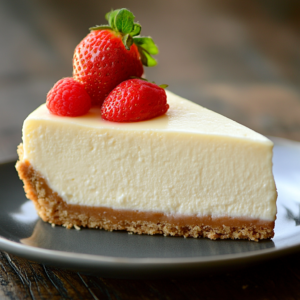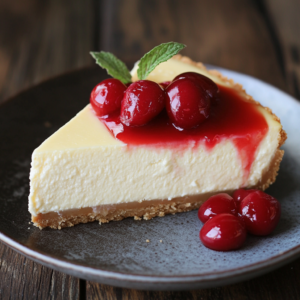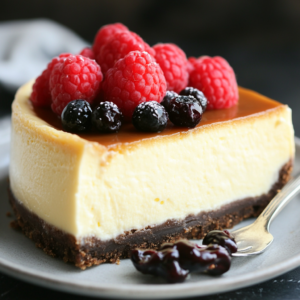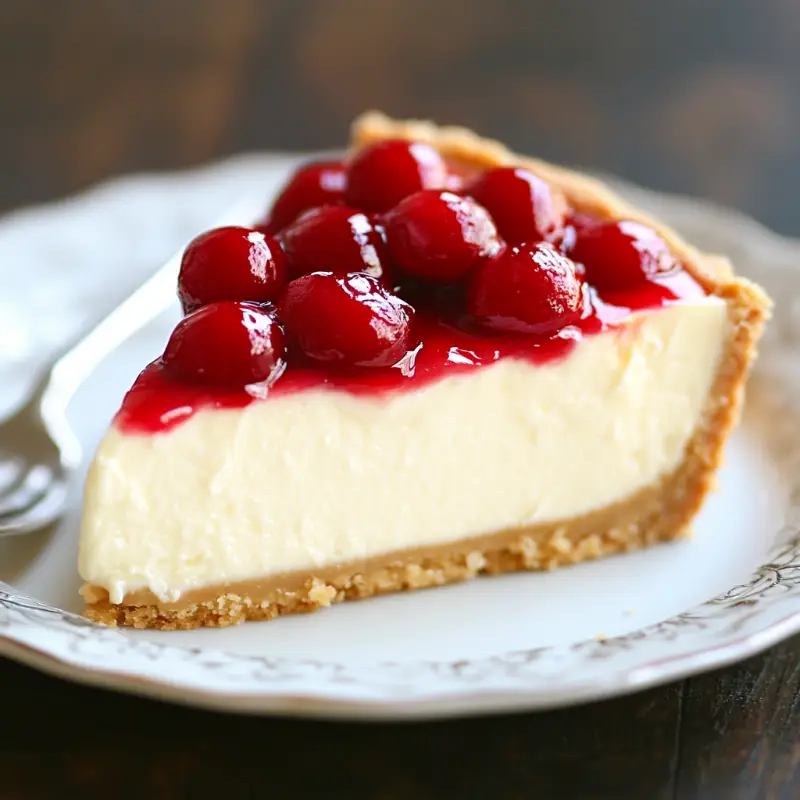When it comes to decadent desserts, the Philadelphia cheesecake holds a special place in the hearts of many. Known for its smooth texture, rich flavor, and versatility, this classic dessert is beloved by both home bakers and professionals alike. In this article, we will guide you through every step of making the perfect Philadelphia cheesecake, from selecting the right ingredients to nailing the cooling process, along with pro tips, FAQs, and variations.
Why Philadelphia Cheesecake?
A cheesecake is not just any dessert; it’s a labor of love. Using Philadelphia cream cheese as the base ingredient gives your cheesecake that iconic silky smooth texture and light tang that other cream cheeses struggle to match. Many bakers swear by Philadelphia’s consistency and flavor, which is why it’s used in countless cheesecake recipes worldwide.
The classic Philadelphia cheesecake is all about simplicity and elegance. The smooth filling, coupled with a crispy graham cracker crust, creates a perfect balance of creaminess and crunch. For anyone aiming for perfection, it’s important to use the right ingredients and follow the correct techniques to get the best results.
Why Quality Ingredients Matter
High-quality ingredients like Philadelphia cream cheese, fresh eggs, and pure vanilla extract can make a world of difference in the final texture and flavor of your cheesecake. The cream cheese should always be at room temperature to avoid lumps. For the crust, ensure you use fresh graham crackers, or you can check out this graham cracker crust recipe for more tips on creating the ideal base.
When it comes to the filling, taking the time to properly mix your ingredients without over-beating the eggs is key. Over-beating introduces too much air into the batter, which leads to cracks forming on the surface of the cheesecake. This issue can be avoided with some simple techniques—find more details on preventing cracks with this guide.
Ingredients for the Perfect Philadelphia Cheesecake

Before getting started, gather your ingredients. Here’s a list of what you’ll need for a classic Philadelphia cheesecake:
For the Crust:
- 1 ½ cups graham cracker crumbs
- 1/3 cup melted butter or margarine
- 3 tablespoons sugar
For the Cheesecake Filling:
- 4 packages (8 oz each) Philadelphia cream cheese, softened
- 1 cup granulated sugar
- 1 teaspoon vanilla extract
- 4 large eggs, at room temperature
Optional Toppings:
- Fresh berries (strawberries, blueberries, raspberries)
- Chocolate drizzle
- Caramel sauce
By keeping your ingredient list simple yet effective, you’ll be setting yourself up for success in the kitchen. The Philadelphia cream cheese gives the cheesecake its signature creaminess, while the crust provides a crunchy contrast.
Step-by-Step Instructions
1. Preparing the Crust
The base of any good cheesecake starts with a perfectly baked crust. The graham cracker crust is both crunchy and slightly sweet, complementing the creamy filling that will come later.
- Preheat the oven to 325°F (160°C).
- Combine the graham cracker crumbs, sugar, and melted butter in a mixing bowl.
- Stir until all the crumbs are evenly moistened.
- Press the crumb mixture firmly into the bottom of a 9-inch springform pan, ensuring it’s evenly distributed.
- Bake for 10 minutes, then set aside to cool.
2. Making the Cheesecake Filling
The filling is the heart of the cheesecake. This part requires careful attention to ensure that the texture remains smooth and creamy.
- Using an electric mixer, beat the Philadelphia cream cheese until smooth. Gradually add sugar and continue beating until well-blended.
- Add vanilla extract and mix until incorporated.
- One at a time, add the eggs, beating on low speed. Do not overmix—just beat until each egg is fully incorporated.
- Pour the filling over the prebaked crust, spreading it evenly.
3. Baking the Cheesecake
Baking your cheesecake at the right temperature and for the correct duration is crucial to getting that perfect texture.
- Place the springform pan into a larger roasting pan and add about an inch of hot water to the roasting pan (this is called a water bath, which prevents cracks).
- Bake the cheesecake at 325°F for about 55 minutes, or until the center is nearly set but still jiggles slightly.
- Once baked, turn off the oven and leave the cheesecake inside with the door slightly cracked open. This allows the cake to cool slowly, preventing cracks from forming.
4. Cooling and Refrigeration
Cooling your cheesecake is a delicate process. Moving it from the oven to the fridge too quickly can cause cracks.
- Let the cheesecake cool in the oven for about an hour.
- Once it reaches room temperature, cover the cheesecake and refrigerate for at least 4 hours (overnight is best) to allow the flavors to meld together and the cheesecake to firm up.
Tips for the Perfect Cheesecake

Mastering the art of cheesecake requires attention to detail and a few important techniques. Here are some essential tips to ensure your Philadelphia cheesecake turns out smooth, creamy, and free of cracks every time:
1. Use Room Temperature Ingredients
- Philadelphia cream cheese and eggs should always be at room temperature. Cold ingredients can lead to lumps in the batter and prevent the filling from achieving its signature smoothness.
2. Don’t Overmix the Batter
- Overmixing the batter, especially after adding the eggs, can incorporate too much air, leading to cracks in the cheesecake. Mix just until the ingredients are incorporated to keep the batter dense and creamy.
3. Use a Water Bath
- A water bath (or bain-marie) helps regulate the baking temperature and creates a moist environment, preventing the cheesecake from cracking. Wrap the springform pan in foil to protect it from water seeping in.
4. Bake Slowly and at Low Temperature
- Cheesecakes bake best at a low temperature (around 325°F). A slow bake ensures an even texture and prevents the surface from browning too much.
5. Cool Gradually
- Rapid temperature changes cause cracks in the cheesecake. Let the cheesecake cool in the oven with the door slightly open for about an hour before transferring it to room temperature.
6. Chill Before Serving
- Refrigerate the cheesecake for at least 4 hours (preferably overnight) to allow it to firm up and for the flavors to fully develop.
7. Slice with a Warm Knife
- For clean, professional-looking slices, run a sharp knife under hot water, wipe it dry, and then cut. Repeat this process between slices to prevent sticking.
By following these tips, your cheesecake will have a velvety texture, no cracks, and a perfectly baked crust every time.
For more information and troubleshooting on how to avoid common mistakes, refer to The Spruce Eats’ guide to avoiding cracks in cheesecake.
Delicious Topping Ideas
Toppings can elevate a classic Philadelphia cheesecake from a simple dessert to a gourmet masterpiece. Here are a few delicious ideas to take your cheesecake to the next level:
1. Fresh Fruit Toppings
- Berries: Strawberries, blueberries, raspberries, and blackberries are popular choices. The acidity and sweetness of berries perfectly complement the creamy richness of cheesecake.
- Citrus Fruits: Thin slices of lemon, lime, or orange zest can add a bright, refreshing touch.
2. Chocolate Drizzle
- Melted chocolate drizzled over the top adds richness and visual appeal. You can also create a chocolate ganache for a more decadent finish.
3. Caramel Sauce
- A sweet caramel drizzle, topped with a sprinkle of sea salt, adds an indulgent, sweet-and-salty flavor combination that works wonderfully with the tanginess of the cream cheese.
4. Nut Toppings
- Pecans, almonds, or walnuts can be roasted and lightly caramelized to add crunch and a slightly savory element.
5. Whipped Cream
- Light, airy whipped cream balances out the dense texture of the cheesecake, making each bite even more satisfying.
6. Compotes and Coulis
- Fruit compotes (such as strawberry or blueberry) or fruit coulis add moisture, flavor, and color. They are easy to make by simmering fruits with sugar until they break down into a thick sauce.
7. Cookie Crumbles
- Crushed Oreo cookies, graham crackers, or even gingersnaps can be sprinkled over the top or added as a base to switch up the texture and flavor.
Serving Suggestions
Serve your Philadelphia cheesecake with style by cutting it into neat slices using a sharp knife. Dip the knife in hot water and wipe it clean between slices for a professional finish. This ensures clean edges and prevents the filling from sticking to the knife.
You can pair the cheesecake with coffee, dessert wines, or even a scoop of vanilla ice cream for an indulgent treat. For special occasions, present the cheesecake on a cake stand with garnishes like mint leaves or edible flowers to wow your guests.
Variations to Try
Philadelphia cheesecake is incredibly versatile, and there are plenty of variations you can try based on personal preference:
Oreo Cheesecake
For a fun twist, try adding crushed Oreos to the crust and folding them into the filling. The result is a decadent, cookies-and-cream-style cheesecake that’s sure to please.
No-Bake Cheesecake
If you’re short on time or don’t want to fuss with a water bath, a no-bake version of Philadelphia cheesecake is a great option. Simply combine the ingredients, pour them over the graham cracker crust, and refrigerate until set.
Chocolate Swirl Cheesecake
Before baking, swirl melted chocolate into the filling to create a marbled effect. This not only looks stunning but adds a rich, chocolaty flavor to each bite.

Frequently Asked Questions (FAQs)
Here are some of the most common questions about making a Philadelphia cheesecake:
1. Can I Use Low-Fat Cream Cheese?
While low-fat cream cheese can be used, it often results in a less creamy texture. For best results, stick to full-fat Philadelphia cream cheese for the richest flavor and texture.
2. How Long Does Cheesecake Last?
Properly stored in an airtight container, Philadelphia cheesecake can last up to 4 days in the refrigerator. It can also be frozen for up to 2 months. To defrost, simply place the cheesecake in the fridge overnight.
3. Can I Freeze Philadelphia Cheesecake?
Yes! You can freeze the entire cheesecake or individual slices. Wrap the cheesecake tightly in plastic wrap and then in foil before placing it in the freezer.
Conclusion
In conclusion, making the perfect Philadelphia cheesecake doesn’t have to be complicated. By following this step-by-step guide, you’ll be able to create a creamy, smooth, and decadent cheesecake that will impress your family and friends. Whether you stick with the classic version or try one of the many variations, this dessert is sure to become a favorite in your household.

